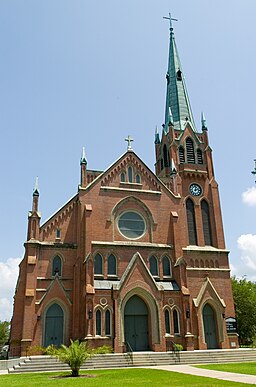Jeanerette, Louisiana
| Jeanerette, Louisiana | |
| City | |
|
St. John the Evangelist Roman Catholic Church, Jeanerette
|
|
| Nickname: Sugar City | |
| Country | United States |
|---|---|
| State | Louisiana |
| Parish | Iberia |
| Elevation | 16 ft (4.9 m) |
| Coordinates | 29°54′59″N 91°40′21″W / 29.91639°N 91.67250°WCoordinates: 29°54′59″N 91°40′21″W / 29.91639°N 91.67250°W |
| Area | 2.2 sq mi (5.7 km2) |
| - land | 2.2 sq mi (6 km2) |
| - water | 0.0 sq mi (0 km2), 0% |
| Population | 5,530 (2010) |
| Mayor | Aprill F. Foulcard (D) (elected 2013 to succeed Timothy S. de'Clouet, who died) |
| Timezone | CST (UTC-6) |
| - summer (DST) | CDT (UTC-5) |
| ZIP code | 70544 |
| Area code | 337 |
|
Location of Louisiana in the United States
|
|
Jeanerette is a small city in Iberia Parish, Louisiana, United States. Known as "Sugar City", it had a population of 5,530 at the 2010 census, a decrease of 467 from the 2000 tabulation of 5,997. It is two thirds African American, many of them Creoles of color.
Jeanerette is the part of the Lafayette, Louisiana Metropolitan Statistical Area. The parish is also one of the 22 included in the Acadiana region, which has had a high proportion of Francophones.
In the 18th century, the land on which Jeanerette now lies was originally procured from the Spanish government by Pierre Zerangue. Zerangue received an “order of survey and settlement” from Spain for 1,052 acres (4.26 km2). Under Spanish law, if a person occupied a piece of property for two years, they could apply for title to the land under an “order of survey settlement.” Nicholas Provost secured the property from the present-day experimental farm to the St. Mary Parish line. He engaged in sugar cultivation, based on slave labor, until his death in 1816.
The town derived its name from John W. Jeanerette, a native of South Carolina who moved to the developing area in the 1820s. First he worked as a tutor for a planter's family, as did numerous educated young adults from northern states, then opened a store and saloon. Having saved some money, about 1830 Jeanerette purchased Pine Grove Plantation, formerly known as Beau Pré (meaning Lovely Meadow/pasture).
Jeanerette offered a portion of his house to be used as a mail depository for the local inhabitants. Later Jeanerette was appointed as the town's first postmaster (he dropped his middle initial.) The name Jeanerette afterward stuck for the post office and town.
During the 19th century, to the north along the Bayou Teche was a settlement of free Creoles of color, now known as Grand Marais. The free persons of color were descended from African and European ancestors, and were often still French speakers into the 20th century.
...
Wikipedia



